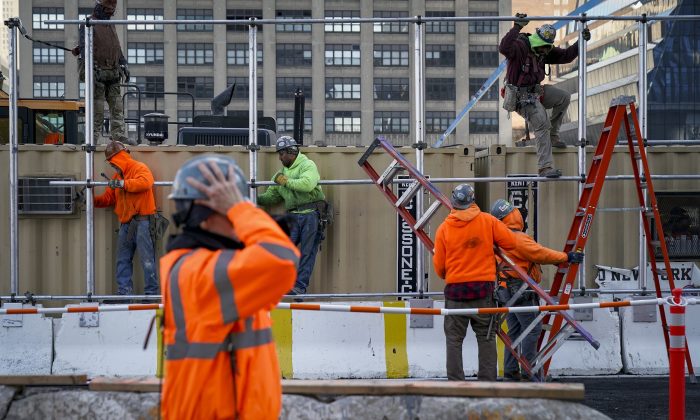The overwhelming majority of construction firms across the nation are struggling to hire concrete workers, pipelayers, carpenters, and other hourly craft personnel, according to an annual survey released Aug. 27 by Autodesk and the Associated General Contractors of America (AGC).
“As this year’s results make clear, workforce shortages remain the single most significant threat to the success of the construction industry,” Stephen Sandherr, the CEO of AGC, said in a call with reporters.
Of the nearly 1,935 construction firms surveyed, 90 percent said they planned to hire additional craft workers or bring on replacements for outgoing hourly staff in the coming year. Yet most are struggling to do so, with 80 percent saying they are having difficulty finding workers.
Large firms doing more than $500 million in business annually are the most affected, with 86 percent saying they’ve had trouble bringing on hourly craft personnel and 83 percent having trouble hiring salaried staff, including project managers, engineers, and quality control personnel.
The shortage is forcing many firms to submit higher price bids for contracts and to extend their estimated completion times, according to Ken Simonson, the chief economist at AGC.
Most construction firms expect it to remain difficult to bring on craft personnel in the coming year, with only 4 percent saying it will be easy or become easier to hire in the next 12 months. The pessimism is driven partly by the quality of the local pipeline for supplying craft personnel. An overwhelming majority of firms rated their local pipelines for employees as poor or fair in terms of overall skill level and the ability to pass drug and background tests.
According to John Madden, the general manager of Inland Asphalt in Spokane, Washington, the labor shortage has resulted in local companies “stealing” employees from each other by offering better pay. As a result, wages are up overall, yet craft worker shortages remain.
“There is really no more capacity to do work. It’s really just the wages are going up,” said Madden, who hires 100 people in the area.
Madden’s company has been forced to bring on workers at a lower skill level and to train and mentor them along the way. But that approach comes with its own hazards since employees with less training run a higher risk of posing a safety concern to themselves and their coworkers.
“It’s just another component of the problem of the worker shortage,” Madden said.
The demographics of the craft workforce show that the workers are older, on average, with many retiring.
Bruce Tibbetts, the president of EMC Mechanical Services in Virginia, turned the trend into an opportunity and converted many of the older workers into trainers and mentors for the younger craft personnel joining the company.
Katie Haydon Perry, the director of organizational development at Haydon Building Corp. in Arizona, also said her company has turned to hire hourly craft workers at a lower skill level and is using experienced personnel to provide on-the-job training. Haydon Building has also turned to an alternative recruitment program, including a re-entry program for people who have had challenges in the past. Perry said the company is also changing the workplace culture, to one where workers are appreciated rather than taken for granted.
A number of forces are contributing to the skilled worker shortage. Among these is a generational cultural shift among Americans who believe that a four-year college degree is the surest way to obtain a stable income in the future. Companies are responding to the shift by reaching out to local junior high schools and promoting the benefits of craft jobs.
“There’s a bias against people working in blue-collar jobs,” Sandherr said, noting that the construction industry isn’t the only one struggling with worker shortages.
Sandherr noted that four-year degrees leave some students in a debt trap, while trade-school graduates tend to earn money while they learn.
The drug epidemic in the United States is also playing a role. According to Sandherr, 25 to 40 percent of skilled labor job applicants fail drug tests. The shortage has forced some firms to lower their requirements, including bringing on people who had marijuana in their system.
The AGC is urging Congress to take action on the issue, by increasing funding for career and technical education programs, proliferating rigorous construction apprenticeship programs, enacting immigration reforms that would allow skilled workers to legally enter the country, and allowing for federal education grants to be used for trade-school tuition.
From The Epoch Times


